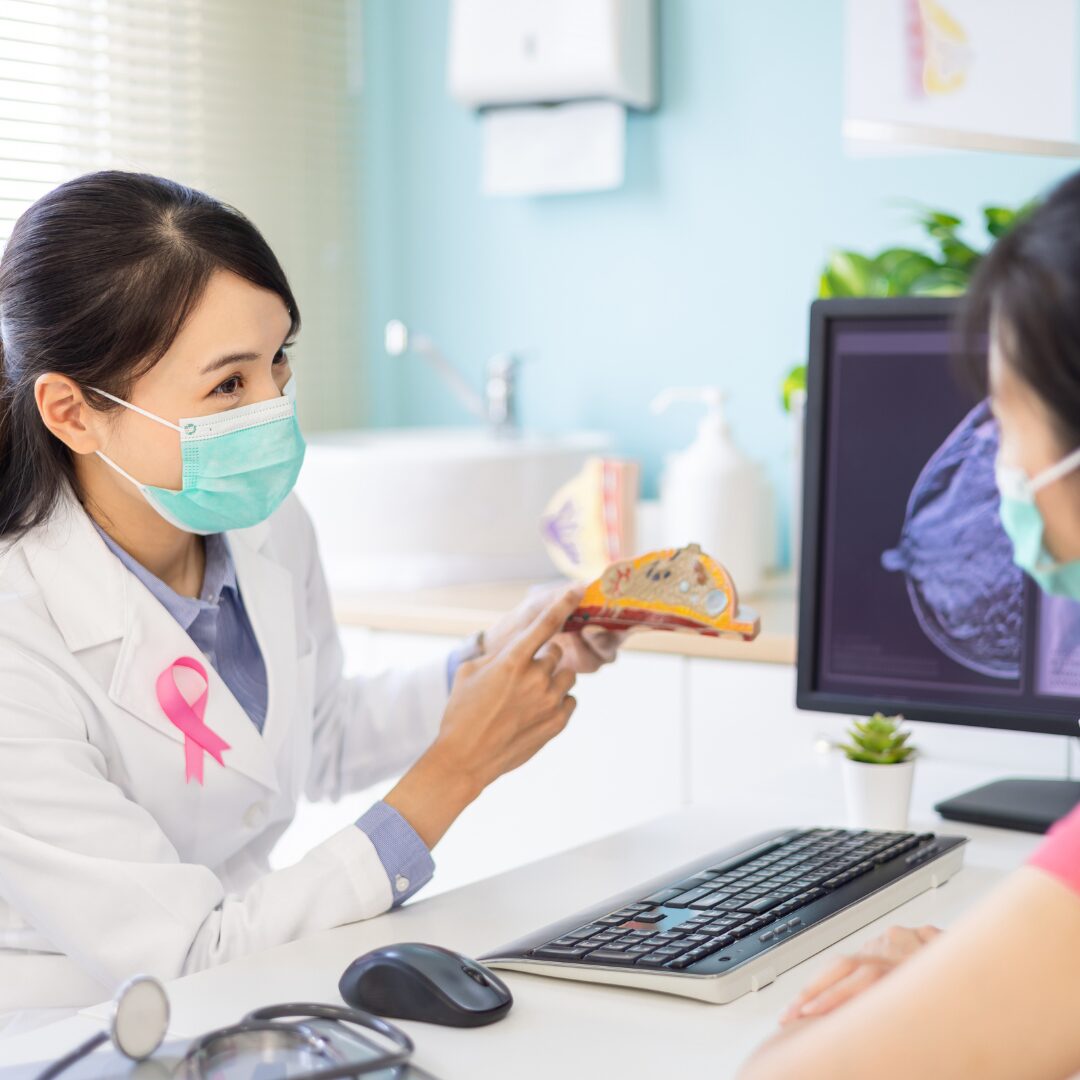Know The Earliest Signs of Breast Cancer
As we observe Breast Cancer Awareness Month, it’s a great time to address an issue affecting many women we care about. Did you know that about 1 in 8 women in the U.S. (13%) will face an invasive breast cancer diagnosis in their lifetime?1 This statistic from Breastcancer.org underscores the vital importance of awareness and early detection.
By knowing the earliest signs of breast cancer, you can make a difference for yourself and your loved ones.
A Quick Overview of Breast Cancer
Breast cancer occurs when cells in the breast begin to grow uncontrollably, forming tumors. It can develop in various areas of the breast, including the ducts and lobules, and can affect both women and men, though it is much more common in women. There are many variations of breast cancer,and the cancer may remain localized or spread to surrounding tissues and other parts of the body. To improve outcomes and survival rates, early detection and treatment are essential.Let’s dive into some of the early signs of breast cancer.
The Most Common Sign of Early Breast Cancer is a New Lump or Mass
According to the American Cancer Society, the most common symptom of breast cancer is the emergence of a new lump or mass, though it’s important to note that most breast lumps are not cancerous. A painless, firm mass with irregular edges is more likely to indicate cancer; however, breast tumors can also be soft, round, tender, or even painful.2
Common Sign of Breast Cancer to Watch For
The most common signs of early breast cancer include:
1. New Lump or Mass: Often the first noticeable symptom, though not all lumps are cancerous.
2. Change in Breast Size or Shape: This can include swelling or distortion of the breast.
3. Nipple Changes: This may involve a change in position, discharge, or inversion of the nipple.
4. Skin Changes: Redness, dimpling, or a texture change in the skin of the breast.
5. Persistent Pain: Any pain in the breast or nipple that doesn’t go away.
Less Common Breast Cancer Indicators to Be Aware Of
6. Swelling or Lump in the Armpit
7. Itching or Rash
We will examine each of these warning signs in more detail below.
Self Breast Examinations Help Identify Starting Signs of Breast Cancer
Self-breast exams are essential for early detection of any changes. By regularly examining your breasts, you become familiar with their normal texture and appearance, making it easier to spot any concerns.

Professional Breast Exams Are Essential In The Fight Against Breast Cancer.
Obria offers low cost professional breast exams, well woman exams and reproductive health screenings. Take control of your health with our caring practitioners today.
An In Depth Dive Into Early Breast Cancer Signs
Lumps of Masses in the Breast
Distinguishing between benign and concerning breast lumps can be tricky, but there are helpful clues. Benign lumps, like cysts or fibroadenomas, often feel smooth, movable, and tender, with well-defined edges. In contrast, concerning lumps may feel hard, have irregular edges, be fixed in place, or cause discomfort.
If you find a lump, don’t panic—note any changes in size, shape, or texture, and contact your healthcare provider for a check-up. They may recommend imaging tests, such as a mammogram or ultrasound, and possibly a biopsy for further evaluation. Early detection is key to taking charge of your breast health, regardless of the lump’s nature.
Changes in Breast Shape or Size
It’s completely normal for your breasts to change in shape or size throughout your life due to hormonal shifts, pregnancy, or aging. However, if you notice a sudden or ongoing change in the size or shape of one breast compared to the other, or if there’s swelling, distortion, or a lump, it’s wise to reach out to your healthcare provider.
Nipple Changes
Changes in your nipples can be significant when it comes to breast health. If you notice any unusual discharge—whether clear, bloody, or another type—it’s important to take note, as this can sometimes indicate an underlying issue. Additionally, if you see that a nipple has become inverted or retracted, which means it pulls inward instead of pointing outward, it’s worth mentioning to your healthcare provider.
Skin Changes of the Breast: Dimpling, Puckering or Texture
Paying attention to skin changes on your breasts is an important part of breast health. If you notice dimpling, puckering, or a change in texture, it could be a sign that something needs to be checked out. Additionally, any color changes, like redness or a rash, should not be overlooked.
Persistant Pain
Unlike typical breast tenderness that might occur with your menstrual cycle, persistent pain—especially if it’s localized or accompanied by other symptoms like swelling or changes in the skin—should not be ignored. If you experience ongoing discomfort that doesn’t go away or worsens over time, it could indicate a problem worth investigating.
Swelling or Lump in the Armpit
Note: This is a less common indicator of breast cancer.
Noticing swelling or a lump in your armpit can indicate that lymph nodes are reacting to something happening in the breast area, including the possibility of breast cancer. Lumps in the armpit may feel firm and can sometimes be accompanied by tenderness or discomfort.
Itching or Rash
Note: This is a less common sign of breast cancer.
Itching or a rash on the breast can be more than just a minor irritation; it may be linked to inflammatory breast cancer (IBC), a rare but aggressive form of the disease. Unlike typical breast cancer symptoms, IBC often presents with noticeable skin changes, including redness, swelling, and a rash that can feel warm or itchy.3 These symptoms occur due to cancer cells blocking lymph vessels in the skin. If you experience persistent itching or a rash that doesn’t improve, it’s important to consult your healthcare provider for a thorough evaluation.

Know When to See a Doctor
Knowing when to see a doctor is crucial for maintaining breast health. If you notice any persistent changes, such as new lumps, skin alterations, unusual discharge, or unexplained pain, it’s important to seek medical advice promptly.
The Importance of Regular Check-Ups and Screenings for Breast Cancer Prevention
Even if you don’t have symptoms, regular check-ups and screenings are vital for early breast cancer detection. Mammograms and clinical breast exams (like those performed during our annual well woman exams) can catch potential issues before they become serious.
At Obria, we provide affordable reproductive health screenings and helpful resources to empower you to take charge of your health in your 20’s, 30’s, 40’s and beyond. Our guides below cover important topics such as self-breast exams, professional check-ups, and mammograms.
- Guide to Reproductive Health in Your 20’s
- Guide to Reproductive Health in Your 30’s
- Guide to Reproductive Health in Your 40’s and 50’s
Summary
Be proactive about your breast health. If you notice any of these signs—such as a new lump or mass, changes in breast size or shape, nipple alterations, skin changes, or persistent pain—it’s important to take action and not hesitate to seek help.
If you are worried about early signs of breast cancer or have any questions or concerns, schedule an appointment. Our clinics and compassionate staff can help you navigate.
We are here to support you and stand united in the fight against breast cancer.

A friendly reminder to share this blog post with your friends and family
Raise awareness about breast cancer and help loved one recognize its earliest signs. Also, consider donating to breast cancer research to support the fight against this disease.
Obria Medical Clinics Offers Low-cost Well Woman Exams & Professional Breast Examinations.
Experience the difference that compassionate, personalized care can make in your healthcare journey.
References:

